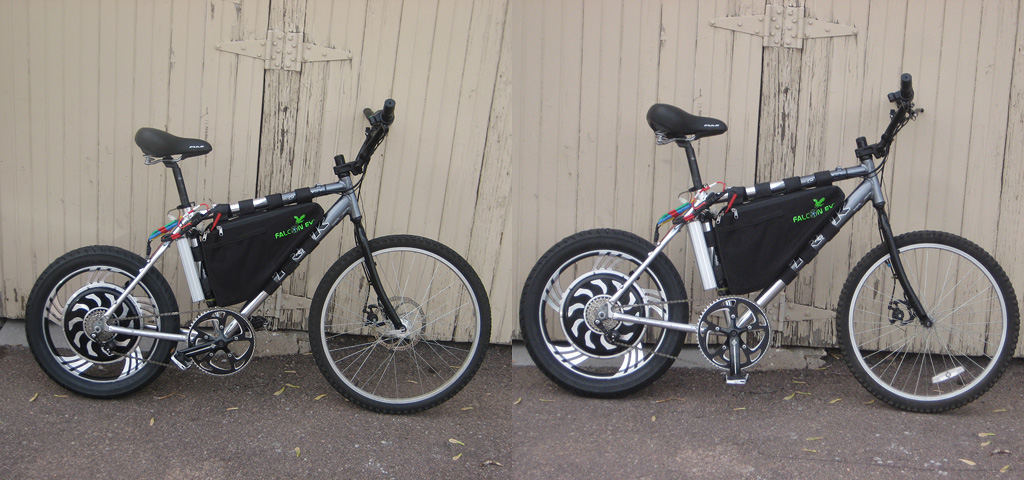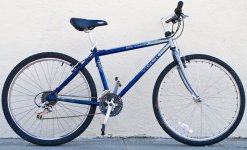Driverkpk
10 mW
Building my 1st E Bike which frame and style works best???
Road bike, mountain bike, beach cruiser??
Steel, chrome moly, aluminum??
Thanks!!
Road bike, mountain bike, beach cruiser??
Steel, chrome moly, aluminum??
Thanks!!
neptronix said:
Aluminum dropouts, huge torque plates, 8000W.. powerful enough to throw a 270lb rider off the back of the bike.. I'd say that aluminum is strong enough for me
biohazardman said:Depends on what you are building it for. How much weight will you haul, how many batteries? Is it for riding on the road, trail, commuting, hill climbing, racing, acceleration, top speed. ect... Your budget will play a large factor as will your perception of safety and often ego. I know that's not much help but there is so much available you have to narrow things down a bit before we can give you much in the way of useful information. You might look around here before you decide to see what others have done.
http://endless-sphere.com/forums/viewtopic.php?f=6&t=235
Driverkpk said:Bike for commuting to work 18-20 miles 6'3 210lbs like to obtain 20mph flat paved trail.
Ykick said:Driverkpk said:Bike for commuting to work 18-20 miles 6'3 210lbs like to obtain 20mph flat paved trail.
One way? If so, can you charge at work? Is there opportunity to get assistance (ride?) if you have a flat tire or suffer some other critical failure?
Often, motorcycle/scooter simply makes more sense for long commutes.
Driverkpk said:Bike for commuting to work 18-20 miles 6'3 210lbs like to obtain 20mph flat paved trail.
biohazardman said:Depends on what you are building it for. How much weight will you haul, how many batteries? Is it for riding on the road, trail, commuting, hill climbing, racing, acceleration, top speed. ect... Your budget will play a large factor as will your perception of safety and often ego. I know that's not much help but there is so much available you have to narrow things down a bit before we can give you much in the way of useful information. You might look around here before you decide to see what others have done.
http://endless-sphere.com/forums/viewtopic.php?f=6&t=235

dogman said:Beach cruiser or hardtail mtb, either one in steel will be ideal for that use.
Till you tell us, we don't know if you will ride street, or try to ride up a ski area. Your needs are easy, so you could do it on almost anything with two wheels.
10 miles each way should be pretty easy. Pick the one that will be the most comfortable to ride. Either type of bike can carry 36v 15 ah battery in the frame. Most direct drive motor kits will go 20-25 mph on 36v.
Brakes, for a typical 36v commuter, v brakes will be fine. Do avoid really cheap caliper brakes, and coaster brakes though. You don't need to spend a fortune on your bike just yet. Start out with something affordable, like under $300 new. Later on, you can decide if your needs justify a more expensive bike. You might decide your road is so rough you want full suspension, or you might decide you want a longtail for cargo, or something exotic like a recumbent or trike.
But the first try is always best to start with a less expensive steel 26" bike with a 7 speed rear gear cluster. Keep it simple the first time. Even the cheapest bike should be good for about 2000 miles of use at least.
"Best?"Driverkpk said:Building my 1st E Bike which frame and style works best???
Driverkpk said:Theres a 95' trek 850 track xc chromoly frame available to me what do you think of that bike for conversion??

dogman said:The trek should be very good very strong frame. Only downside I see is that the frame triangle is a bit small. This limits the size battery you can carry in that ideal spot, the front frame triangle. It should be old enough to be only a 7 or 8 speed. 7 speed rear gears are the ideal thing for a rear hubmotor.
